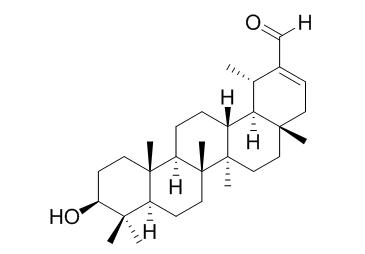30-Oxopseudotaraxasterol
30-Oxopseudotaraxasterol is a natural product from Pulicaria canariensis ssp. lanata.
Inquire / Order:
manager@chemfaces.com
Technical Inquiries:
service@chemfaces.com
Tel:
+86-27-84237783
Fax:
+86-27-84254680
Address:
1 Building, No. 83, CheCheng Rd., Wuhan Economic and Technological Development Zone, Wuhan, Hubei 430056, PRC
Providing storage is as stated on the product vial and the vial is kept tightly sealed, the product can be stored for up to
24 months(2-8C).
Wherever possible, you should prepare and use solutions on the same day. However, if you need to make up stock solutions in advance, we recommend that you store the solution as aliquots in tightly sealed vials at -20C. Generally, these will be useable for up to two weeks. Before use, and prior to opening the vial we recommend that you allow your product to equilibrate to room temperature for at least 1 hour.
Need more advice on solubility, usage and handling? Please email to: service@chemfaces.com
The packaging of the product may have turned upside down during transportation, resulting in the natural compounds adhering to the neck or cap of the vial. take the vial out of its packaging and gently shake to let the compounds fall to the bottom of the vial. for liquid products, centrifuge at 200-500 RPM to gather the liquid at the bottom of the vial. try to avoid loss or contamination during handling.
Phytomedicine.2022, 96:153877.
Environ Toxicol.2024, 39(4):2417-2428.
Biomed Chromatogr.2016, 30(10):1573-81
Sci Rep. 2024, 14(1):70.
Molecules.2019, 24(6):E1155
Food Sci Nutr.2023, 00:1-10.
The Journal of Korean Medicine2022, 43(3): 79-93.
Universitat Stuttgart2022, opus-12200.
Biomed Pharmacother.2021, 144:112300.
Food Control2022, 132:108434.
Related and Featured Products
Chem Biodivers. 2011 Nov;8(11):2080-9.
Secondary metabolites from two species of Pulicaria and their cytotoxic activity.[Pubmed:
22083919]
Two new compounds, the sesquiterpene (1E,5E)-8β-acetoxy-4α-hydroxy-7βH-germacra-1(10),5-dien-14-oic acid (2), and a nor-sesquiterpene, (5E)-8β-acetoxy-4α-hydroxy-7βH-germacr-5-en-10-one (3), were isolated from Pulicaria canariensis ssp. lanata, along with ten known compounds, including the flavonoid 5,3'-dihydroxy-3,7,4'-trimethoxyflavone (4).
METHODS AND RESULTS:
From Pulicaria burchardii, we isolated seven known compounds; the physical and spectroscopic data of the triterpenoid 3β-hydroxytaraxaster-20-en-30-al (30-Oxopseudotaraxasterol,1) are reported. The structures of compounds 1-3 were determined on the basis of HR-MS, and 1D- and 2D-NMR studies. The structure of 2 was corroborated by X-ray crystal diffraction.
CONCLUSIONS:
Cell viability experiments revealed that the semisynthetic flavonoid 4b was the most cytotoxic compound against human leukemia cells, and the cytotoxicity was caused by induction of apoptosis, as determined by microscopy of nuclear changes.



